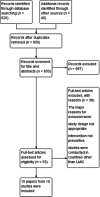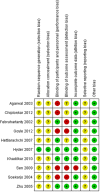Effects of preventive nutrition interventions among adolescents on health and nutritional status in low- and middle-income countries: A systematic review
- PMID: 37131413
- PMCID: PMC8356321
- DOI: 10.1002/cl2.1085
Effects of preventive nutrition interventions among adolescents on health and nutritional status in low- and middle-income countries: A systematic review
Abstract
Background: Malnutrition is one of the most common causes of morbidity and mortality among children and adolescents and is now considered to be one of the largest risk factors responsible for the global burden of diseases along with poor diet.
Objectives: The objective of this review was to assess the impact of preventive nutrition interventions (including nutrition education and counselling; micronutrient supplementation/fortification and macronutrient supplementation) to improve the health and nutritional status of adolescents aged 10-19 years in low- and middle-income countries (LMICs). The secondary objective of the review was to assess various contextual factors based on the World Health Organisation (WHO) health system building blocks framework that might potentially impact the effectiveness of these interventions for this age group.
Search methods: The search was conducted on Cochrane Controlled Trials Register (CENTRAL), MEDLINE, EMBASE, CINAHL, PsycINFO, the WHO nutrition databases, CAB Global Health, Social Science Citation Index, Scopus, WHO Global Health Index, ADOLEC and EPPI until February 5, 2019. We searched Google Scholar along with key nutrition agencies database such as Nutrition International, the Global Alliance for Improved Nutrition, the World Food Programme and HarvestPlus to search for nonindexed, grey literature to locate relevant programme evaluations and any additional trials. All searches were performed without any restrictions on publication date, language or publication status.
Selection criteria: We included randomised controlled trials, quasiexperimental studies, controlled before-after studies and interrupted time series evaluating the effectiveness of preventive nutrition interventions among adolescents between 10 and 19 years of age from LMICs.
Data collection and analysis: Two review authors independently assessed trials for inclusion, assessed risk of bias and extracted data from included studies. Meta-analysis was conducted separately for each outcome and intervention. For dichotomous data, we reported risk ratios (RR) with 95% confidence intervals (CI). For continuous data, we reported the mean difference (MD) or standard mean difference (SMD) with 95% CI.
Main results: This review summarises findings from a total of 10 studies from 15 papers including 10,802 participants. All the studies included in this review assessed the impact of micronutrient supplementation/fortification on health and nutritional status among adolescents in LMIC. We did not find any study assessing the impact of nutrition education and counselling or on macronutrient supplementation among adolescents. Micronutrient supplementation/fortification interventions included calcium/vitamin D supplementation/fortification, iron supplementation with or without folic acid, zinc supplementation and multiple micronutrient (MMN) fortification. The majority of the studies (eight out of 10 studies) included adolescent girls aged between 10 and 19 years of age. We did not find any large scale preventive nutrition intervention programmes targeting adolescents in LMICs. We are uncertain of the effect of iron supplementation with or without folic acid on anaemia (daily supplementation; RR: 1.04, 95% CI 0.88, 1.24; one study; 1,160 participants; low quality evidence. Weekly supplementation; RR: 1.07, 95% CI: 0.91, 1.26; one study; 1,247 participants; low quality evidence). We are uncertain of the effect of various micronutrient supplementation/fortification on body mass index (calcium/vitamin D supplementation; (MD: -0.01 kg/m2; 95% CI: -1.20, 1.17; two studies; 730 participants; I 2 94%; very low quality evidence, iron supplementation with or without folic acid; MD: 0.29 kg/m2; 95% CI: -0.25, 0.83; two studies; 652 participants; I 2 69%; very low quality evidence, zinc supplementation; MD: 0.35 kg/m2; 95% CI: -0.15, 0.85; one study; 382 participants; very low quality evidence) and MMN fortification; MD: 0.23 kg/m2, 95% CI: -0.11, 0.57; two studies; 943 participants; I 2 22%; very low quality evidence). None of the included studies reported any other primary outcomes including morbidity or adverse effects. Iron supplementation with or without folic acid may improve haemoglobin concentrations (MD: 0.42 g/dL, 95% CI: 0.13, 0.71; four studies; 1,020 participants; I 2 89%; low quality evidence). Calcium/vitamin D supplementation may improve serum 25(OH) D levels (standardised mean difference [SMD]: 2.85, 95% CI: 0.89, 4.82; two studies; 395 participants; I 2 99%; low quality evidence). We are uncertain of the effect of calcium only supplementation (MD: 0.02 g/cm2, 95% CI: -0.00, 0.04; one study; 233 participants; low quality outcome) and calcium + vitamin D supplementation (MD: 0.02 g/cm2, 95% CI: -0.00, 0.04; one study; 235 participants; low quality evidence) on total bone mineral density (BMD). We are uncertain of the effect of MMN fortification on haemoglobin concentrations (MD: -0.10 g/dL, 95% CI: -0.88, 0.68; two studies; 1102 participants; I 2 100%; very low quality evidence); calcium supplementation on total body bone mineral content (BMC); (MD: 30.20 g, 95% CI: -40.56, 100.96; one study; 233 participants; low quality evidence), calcium + vitamin D supplementation on total body BMC (MD: 21.60 g, 95% CI: -45.32, 88.52; one study; 235 participants; low quality evidence) and zinc supplementation on serum zinc levels (SMD: 6.94, 95% CI: -4.84, 18.71; two studies; 494 participants; very low quality evidence). One study reported the impact of iron supplementation with or without folic acid on cognition of adolescent girls suggesting improved cognition in most of the tests with daily or twice weekly supplementation compared to once weekly or no supplementation. None of the other secondary outcomes were reported including any other development outcomes and all-cause mortality. These findings warrant caution while interpreting due to very few studies and high heterogeneity.
Authors' conclusions: There is limited evidence of micronutrient supplementation/fortification among adolescents on health and nutritional status in LMICs, with lack of evidence on nutrition education and counselling and macronutrient supplementation. The findings are generaliseable for adolescent girls since all studies (except one) targeted female adolescents.
© 2020 The Authors. Campbell Systematic Reviews published by John Wiley & Sons Ltd on behalf of The Campbell Collaboration.
Conflict of interest statement
The authors declare that there are no conflict of interests.
Figures







Update of
- Protocol
References
REFERENCES TO STUDIES
Included Studies
-
- Agarwal, K. N. , Gomber, S. , Bisht, H. , & Som, M. (2003). Anemia prophylaxis in adolescent school girls by weekly or daily iron‐folate supplementation. Indian Pediatrics, 40(4), 296–302. - PubMed
-
- Chiplonkar, S. A. , & Kawade, R. (2012). Effect of zinc‐and micronutrient‐rich food supplements on zinc and vitamin A status of adolescent girls. Nutrition, 28(5), 551–558. - PubMed
-
- Februhartanty, J. , Dillon, D. , & Khusun, H. (2002). Will iron supplementation given during menstruation improve iron status better than weekly supplementation? Asia Pacific Journal of Clinical Nutrition, 11(1), 36–41. - PubMed
-
- Goyle, A. , & Prakash, S. (2010). Effect of supplementation of micronutrient fortified biscuits on haemoglobin and serum iron levels of adolescent girls from Jaipur city, India. Nutrition and Food Science, 40(5), 477–484.
-
- Goyle, A. (2012). Effect of micronutrient fortified biscuit supplementation on the weight, height and BMI of adolescent girls. Collegium Antropologicum, 36(2), 573–579. - PubMed
Excluded Studies
-
- Abrams, S. A. , Griffin, I. J. , Hawthorne, K. M. , Gunn, S. K. , Gundberg, C. M. , & Carpenter, T. O. (2005). Relationships among vitamin D levels, parathyroid hormone, and calcium absorption in young adolescents. The Journal of Clinical Endocrinology and Metabolism, 90(10), 5576–5581. - PMC - PubMed
-
- Ahmed, F. , Khan, M. R. , Akhtaruzzaman, M. , Karim, R. , Marks, G. C. , Banu, C. P. , … Williams, G. (2005). Efficacy of twice‐weekly multiple micronutrient supplementation for improving the hemoglobin and micronutrient status of anemic adolescent school girls in Bangladesh. The American Journal of Clinical Nutrition, 82(4), 829–835. - PubMed
-
- Ahmed, F. , Khan, M. R. , Akhtaruzzaman, M. , Karim, R. , Williams, G. , Torlesse, H. , … Nahar, B. (2010). Long‐term intermittent multiple micronutrient supplementation enhances hemoglobin and micronutrient status more than iron+ folic acid supplementation in bangladeshi rural adolescent girls with nutritional anemia. The Journal of Nutrition, 140(10), 1879–1886. - PubMed
-
- Angeles‐Agdeppa, I. , Schultink, W. , Sastroamidjojo, S. , Gross, R. , & Karyadi, D. (1997). Weekly micronutrient supplementation to build iron stores in female Indonesian adolescents. American Journal of Clinical Nutrition, 66, 177e83–183e83. - PubMed
-
- Beasley, N. M. , Tomkins, A. M. , Hall, A. , Lorri, W. , Kihamia, C. M. , & Bundy, D. A. (2000). The impact of weekly iron supplementation on the iron status and growth of adolescent girls in Tanzania. Tropical Medicine and International Health, 5(11), 794–799. - PubMed
Other References
-
- Akseer, N. , Al‐Gashm, S. , Mehta, S. , Mokdad, A. , & Bhutta, Z. A. (2017). Global and regional trends in the nutritional status of young people: A critical and neglected age group. Annals of the New York Academy of Sciences, 1393(1), 3–20. - PubMed
-
- Allen, L. H. , De Benoist, B. , Dary, O. , & Hurrell, R. , World Health Organization . (2006). Guidelines on food fortification with micronutrients. World Health Organization.
-
- Ameratunga, S. N. (2017). Country‐level data informing a sustainable development agenda for adolescents. Journal of Adolescent Health, 61(4), 405–406. - PubMed
-
- Baldasso, J. G. , Galante Andrea, P. , & De Piano Ganen, A. (2016). Impact of actions of food and nutrition education program in a population of adolescents. Revista de Nutrição, 29(1), 65–75.
-
- Balshem, H. , Helfand, M. , Schünemann, H. J. , Oxman, A. D. , Kunz, R. , … Brozek, J. (2011). GRADE guidelines: 3. Rating the quality of evidence. Journal of Clinical Epidemiology, 64(4), 401–406. - PubMed
Publication types
LinkOut - more resources
Full Text Sources
